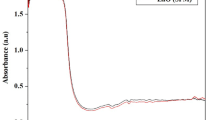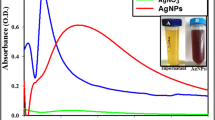Abstract
The use of cyclic experiments, where the product of one reaction becomes the starting material for the next experiment, was proposed as an effective protocol for waste minimization in an educational lab. A simple, cheap and pollution-free method was developed for recovering silver as nano-silver colloidal dispersion from waste silver chloride in the laboratories of the Faculty of Health, Safety and Environment. Silver nanoparticles of the size 5–18 nm were recovered in the presence of sodium borohydride as a reducing agent and polyvinylpyrrolidone as a stabilizer agent. The nano-silver particles were studied for their formation, structure, stability and size using UV–Vis spectroscopy, transmission electron microscopy and dynamic light scattering techniques. The antibacterial assays of nanoparticles showed satisfactory results for Escherichia coli ATCC25922, Staphylococcus aureus ATCC 29213, and Acinetobacter baumanii (Clinical isolate). A laboratory experiment was designed in which students synthesize yellow colloidal silver solution from chemical waste silver chloride and estimate particle size using visible spectroscopy.





Similar content being viewed by others
References
http://www.tropical-rainforest-animals.com/pollution-effects.html. Accessed Jan 2013
http://infohouse.p2ric.org/ref/01/text/00779/ch02.htm. Accessed Jan 2013
American Chemical Society (2002). Less is Better: Guide to minimizing waste in laboratories
Aktas S (2010) Silver recovery from spent silver oxide button cells. Hydrometallurgy 104:106–111
Tang B, Yu G, Fang J, Shi T (2010) Recovery of high-purity silver directly from dilute effluents by an emulsion liquid membrane-crystallization process. J Hazard Mater 177:377–383
Wang L, Xing R, Liu S, Yu H, Qin Y, Li K, Feng J, Li R, Li P (2010) Recovery of silver (I) using a thiourea-modified chitosan resin. J Hazard Mater 180:577–582
Koseoglu H, Kitis M (2009) The recovery of silver from mining wastewaters using hybrid cyanidation and high-pressure membrane process. Miner Eng 22:440–444
Zhouxiang H, Jianying W, Ma Z, Jifan H (2008) A method to recover silver from waste X-ray films with spent fixing bath. Hydrometallurgy 92:148–151
Duoqiang L, Jikun W, Yunhua W, Jibo J, Fan W (2008) Recovery of silver and zinc by acid pressure oxidative leaching of silver -bearing low-grade complex sulfide ores. Int J Miner Process 89:60–64
Syed S, Suresha S, Sharma LM, Syed AA (2002) Clean technology for the recovery of silver from processed radiographic films. Hydrometallurgy 63:277–280
Klabunde K (ed) (2001) Nanoscale materials in chemistry. Wiley Interscience, New York, p 23
Chen CN, Huang CT, Tseng WJ, Wei MH (2010) Dispersion and rheology of surfactant-mediated silver nanoparticle suspensions. Appl Surf Sci 257:650–655
Vaidyanathan R, Gopalram S, Kalishwaralal K, Deepak V, Pandian SRK, Gurunathan S (2010) Enhanced silver nanoparticle synthesis by optimization of nitrate reductase activity. Colloids Surf B 75:335–341
Michna A, Adamczyk Z, Siwek B (2010) Silver nanoparticle monolayers on poly (ethylene imine) covered mica produced by colloidal self-assembly. J Colloid Interface Sci 345:187–193
Yoksan R, Chirachanchai S (2010) Silver nanoparticle-loaded chitosan–starch based films: fabrication and evaluation of tensile, barrier and antimicrobial properties. Mater Sci Eng C 30:891–897
Martinez-Gutierrez F, Olive PL, Banuelos A, Orrantia E, Nino N, Sanchez EM, Ruiz F, Bach H, Av-Gay Y (2010) Synthesis, characterization, and evaluation of antimicrobial and cytotoxic effect of silver and titanium nanoparticles. Nanomed Nanotechnol Biol Med 6:681–688
Yonezawa T, Genda H, Koumoto K (2003) Cationic silver nanoparticles dispersed in water prepared from insoluble salts. Chem Lett 32(2):194–195
Kelly LK, Coronado E, Zhao L, Schatz GC (2003) The optical properties of metal nanoparticles: the influence of size, shape, and dielectric environment. J Phys Chem B 107:668–677
Moores A, Goettmann F (2006) The plasmon band in noble metal nanoparticles: an introduction to theory and applications. New J Chem 30:1121–1132
Clinical and Laboratory Standards Institute (2009) Methods for dilution antimicrobial susceptibility tests for bacteria that grow aerobically. Approved standard M7-A7′, vol 26, no 2
Acknowledgments
The authors gratefully acknowledge the National Elites Foundation, Iran, for providing financial support to the project.
Author information
Authors and Affiliations
Corresponding author
Rights and permissions
About this article
Cite this article
Khaloo, S.S., Torabbeigi, M., Jazani, R.K. et al. Laboratory waste minimization by recovery of silver as nano-silver colloidal dispersion from waste silver chloride. J Mater Cycles Waste Manag 15, 342–347 (2013). https://doi.org/10.1007/s10163-013-0123-z
Received:
Accepted:
Published:
Issue Date:
DOI: https://doi.org/10.1007/s10163-013-0123-z




